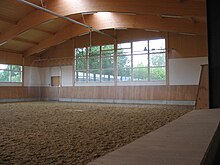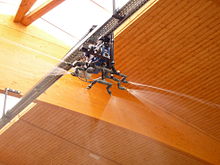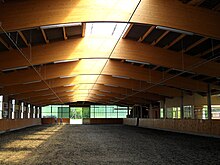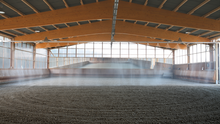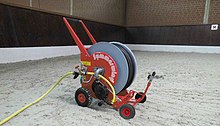Riding arena irrigation
A riding arena irrigation system is an irrigation system for riding arenas . It serves to bind dust and regulate moisture in riding surfaces in riding halls.
Basics
Most of the floors used in riding arenas are sandy floors that are built as a purely natural product or with additives in the form of wood chips or geotextiles . For the purpose of binding dust, the riding surface must be kept moist in order to protect rider and horse from respiratory diseases. Another function of the riding arena irrigation is the preservation of specific pedaling and suspension properties of the riding surface. It is particularly important that the riding arena irrigation works particularly evenly and that individual sections can be irrigated to compensate for solar radiation and air currents.
The riding surface must have the same degree of moisture across the entire riding surface. An uneven arena irrigation means that the riding surface in a riding arena has different strengths. So it is very difficult for the horse to perform well. In particularly dry or wet areas, a horse can slip and injure itself.
Due to the current demands on sport horses and their training conditions, the irrigation systems must be taken into account in the cost calculation when planning new riding arenas.
Systems
Side sprinkler
Several rocker arm sprinklers or geared sprinklers are mounted above the bridle. The sprinklers in the corner spray at a 90 ° angle, all other sprinklers spray at a 180 ° angle. Since the sprinklers are radial work areas, i.e. quarter or semicircular, and the riding area is always rectangular, areas are created that are irrigated once, twice or more than once. Thus this form of indoor irrigation is very imprecise. Irrigation of individual sections is only possible to a limited extent.
Nozzle pipes
Several pipes , usually made of PVC, are installed alongside the roof of a riding arena . A riding arena irrigation system for a riding area measuring 20 × 40 m normally consists of five parallel pipes. The nozzles are mounted on these pipes at constant intervals. Sectional irrigation is possible because the pipes in common nozzle pipe systems have to be controlled individually.
Mobile systems
In the case of drivable indoor irrigation systems, a running rail is mounted under the roof ridge on which a so-called locomotive, driven by an electric motor, sits. A nozzle bar or spray cross is usually mounted on this locomotive. The way in which the nozzle bar works is similar to that of an agricultural field sprayer and is characterized by a particularly high level of uniformity in the irrigation. The spray cross irrigates the riding area from the center with six nozzles; the separate control of the nozzles also allows this irrigation to be divided into many individual areas. This is particularly advantageous in riding arenas with varying levels of drying of the footing. Since mobile riding arena irrigation systems are usually equipped with an electronic control system, individual sections can be irrigated separately in both the transverse and longitudinal directions. This is an advantage especially in riding arenas with glazed gables, often open gates and light ridges. Mobile riding arena irrigation systems have been on the market since the late 1990s and meet modern requirements in equestrian sports.
Irrigation machines
Irrigation machines that do not have permanently installed irrigation systems are also used in riding arenas . They roll up automatically during the irrigation process, so that even moistening of the riding surface is guaranteed. It is also switched off automatically at the end of the irrigation process. A domestic water connection is sufficient for modern systems, as these already work with 2 bar water pressure. Irrigation machines are usually more for outdoor use, e.g. B. suitable on riding arenas .
literature
- Gerlinde Hoffmann, German Equestrian Association: "Orientierungshilfe Reitanlagen- & Stallbau", Warendorf 2009, pp. 123 f and 141 ff, ISBN 978-3-88542-740-7
- Manfred Fischer, Department for Food, Agriculture and Forests, Fürstenfeldbruck: "Care and maintenance of pedal surfaces in riding halls and outdoor areas" in BauBriefe Landwirtschaft, No. 49, horse keeping, p. 126f, Deutscher Landwirtschaftsverlag GmbH, Hanover 2011
Web links
- Cost calculation for riding arenas of the Ministry for Rural Areas and Consumer Protection Baden-Württemberg (MLR) (PDF; 89 kB)
Individual evidence
- ↑ https://www.landwirtschaft-bw.info/servlet/PB/show/1171525/rps_Kostenkalkulation%20f%C3%BCr%20Reithallen.pdf
- ↑ Gerlinde Hoffmann, German Equestrian Association: "Orientierungshilfe Reitanlagen- & Stallbau", chap. 4.5. Warendorf 2009, ISBN 978-3-88542-740-7
